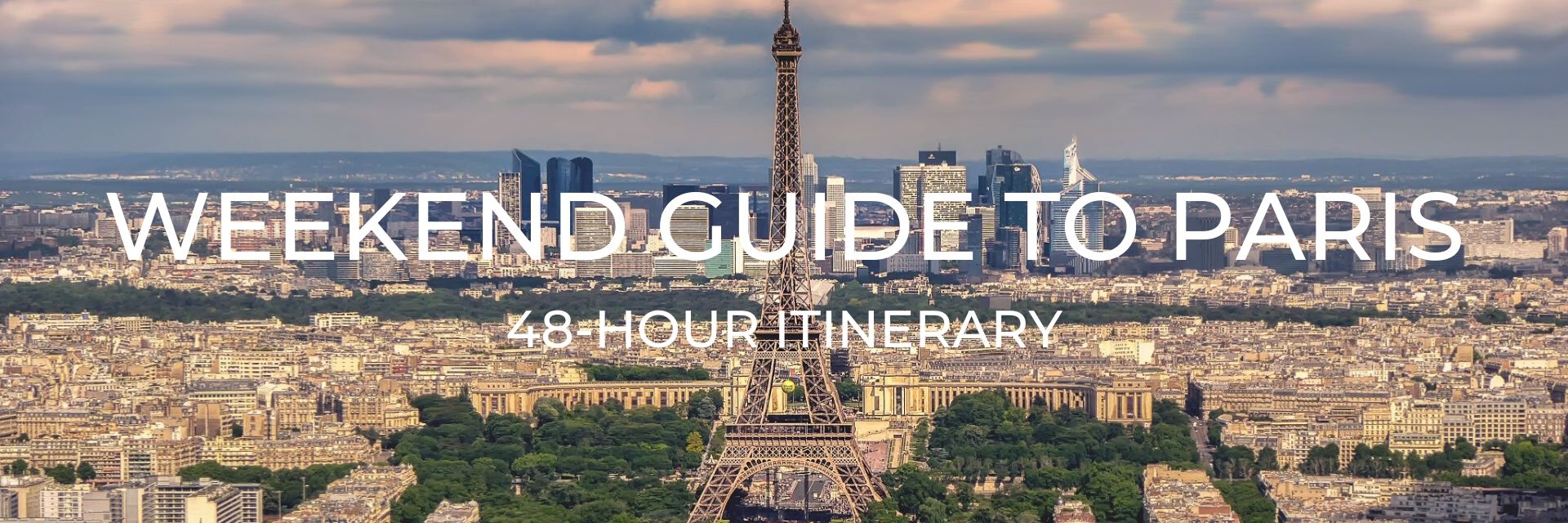
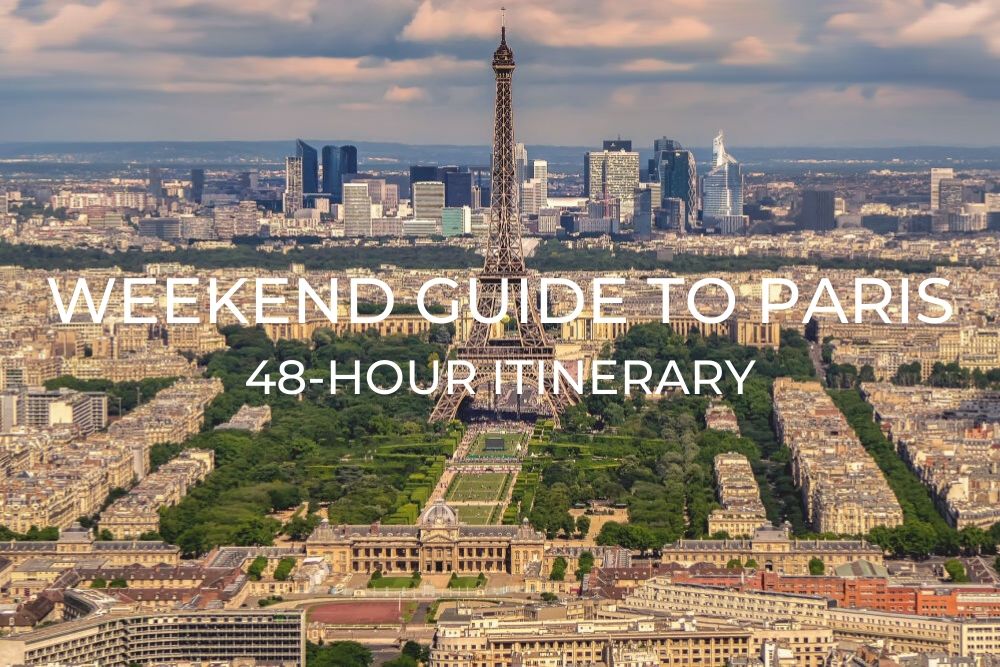
Few cities in the world have so many world-class museums, majestic monuments, well-known landmarks, and beautiful gardens in such a compact, easily walkable areas as Paris. This might have you feeling a bit overwhelmed planning your trip to the city, especially if you only have a weekend to visit. Where do you even begin?
Most cities, like Paris, can’t truly be “done” in one weekend, but you can certainly get a taste of all the city has to offer, especially with a little planning which is where this weekend guide can help. It includes a sampling of the top sights such as beautiful beaux art buildings, the intricate arching bridges, lush green parks and squares, the spires and domes of great churches and cathedrals, all while leaving a little time to just wander the pretty cobblestone streets. And if you’re like us, you’ll love what you see and will put Paris on your list of cities to return to for further exploring.
Want to save this for later? Click the Pinterest button on the left for a pinnable image!
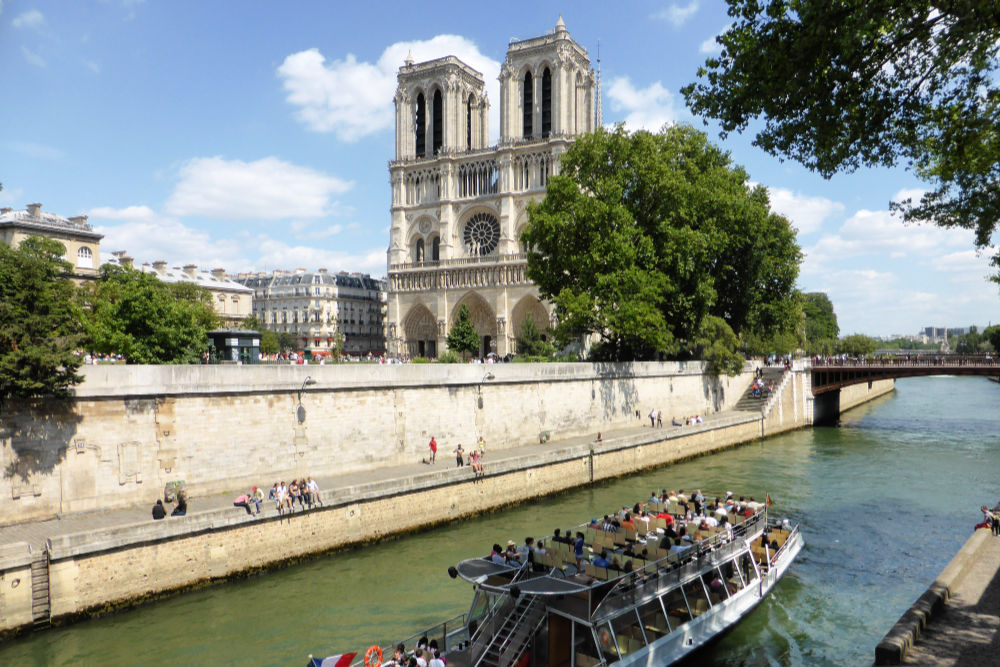
This post may contain affiliate links. Please read our full disclosure policy here.
To learn a little more about Paris pre-trip we recommend Rick Steves’ TV episodes on Paris which give you an introduction to many of the sites mentioned in this guide and can be watched for free on his website or on YouTube or his travel guide if you’d prefer a book you can take along with you on your trip. We hope you enjoy your weekend in Paris!
WHERE TO STAY IN PARIS
How do you even start to pick a place to stay in Paris? The hotel options are truly countless. In Paris, we recommend choosing a hotel close to the main sites, for wonderful walks in the city, or near the métro for quick and easy transport around the city.
For this itinerary three options are:
CITIZEN M PARIS LA DEFENSE $ – For affordable rates with smart technology and clever modern design, check out the Citizen M hotel near La Défense and only 6-minute walk to La Défense Metro and RER station which provides direct access to central Paris. The décor is colourful and fresh and the hotel has a stylish and comfortable ‘living room’ space instead of the traditional lobby, a canteen with lots of options, and a great terrace space to get outside and watch the city!
BOOK YOUR STAY: Direct with Hotel | Hotels.com | Booking.com | TripAdvisor
HOTEL GUSTAVE $$ – For a charming 4-star boutique hotel with stylish and modern rooms with views of the Eiffel Tower, the Hotel Gustave is a great option. It’s only a 15-minute walk to the Champs de Mars and the Eiffel Tower and is on a quiet residential street near a metro station to help you get around the city easily. Room décor is inspired by the Belle Epoque with images of the Eiffel Tower, Grand Palais or Petit Palais to watch over you while you sleep. There is also a buffet breakfast of cooked and cold items served in the breakfast room, or you can enjoy a continental breakfast I the comfort of your room.
BOOK YOUR STAY: Direct with Hotel | Hotels.com | Booking.com | TripAdvisor
HOTEL REGINA LOUVRE $$$ – For a taste of luxury near the Louvre, the Hotel Regina Louvre may be just right for you. It is located in the heart of Paris in the fashion, shopping, and museum district and overlooks the Louvre. Inside you’ll find elegant air-conditioned rooms with period furniture and stunning common areas such as the lobby, restaurant and the ‘English Bar’ which was inspired by the opulence of Victorian England. Two metro stations within 150 metres provide quick and easy access throughout the city.
BOOK YOUR STAY: Direct with Hotel | Hotels.com | Booking.com | TripAdvisor
If, like us, you prefer the comforts of home while on the road, an Airbnb might be ideal for you. Click to see what is available in Paris.
NEW TO AIRBNB? Click for a discount on your first booking when you sign up for a new account.
HOW TO GET AROUND PARIS
For getting around Paris, we recommend the Paris Visite Pass which is what we’ve used on all of our visits to the city.
It includes unlimited travel on public transport in Paris (zone 1-3) or in Paris and Île-de-France region (all zones, including airport connections, Orlyval, Disneyland Paris, and Château de Versailles). All the attractions in this weekend guide can be accessed with the zone 1-3 pass.
The pass can be purchased for 1, 2, 3, or 5 consecutive days and includes 100€ in reductions and special offers from their partners.
To help you navigate to the attractions in this weekend guide we’ve included the closest metro stop and the line(s) the stop(s) are on with links to the portion of the metro map for each metro line. We have also included directions between sights which you will find in italics.
We recommend you download the metro map, or pick up a copy once you arrive in the city. You can also download the app “Next Stop Paris” which will help you navigate the city.
HELPFUL LINKS:
- Click to learn more about the Paris Visite Pass or purchase your card in advance.
- If you are unfamiliar with the Paris métro, don’t worry! Here is a great guide to explain how it all works.
- If you need an app that will navigate you around whether walking, driving or using public transport and even works offline then click for a guide about how to use Here WeGo.
FRIDAY EVENING
Perched on a hilltop known as La Butte, the Montmartre area captures the essence of Old Paris and is a fantastic starting point for any first-time visitor to the city.
With its cobblestone streets and romantic street lamps, a stroll through the area will take you back to earlier times when artists flocked to this little village. Today street artists still set up their easels so you can admire their work, chat for a little bit to practice your French, and find a one-of-a-kind souvenir to remind you of your wonderful weekend in Paris.
To reach the Montmartre area take the métro to the Anvers (M°2) or Abbesses (M°12) stops. Once there you can follow the signs towards the funicular if you’d like to take that the rest of the way up the hill to Sacré-Coeur. You can use your métro tickets for the funicular.
You can stroll up through the streets to climb the hill to Sacré-Coeur, or hop on the funiculaire and it will whisk you from the base of Montmartre butte right up to the basilica.
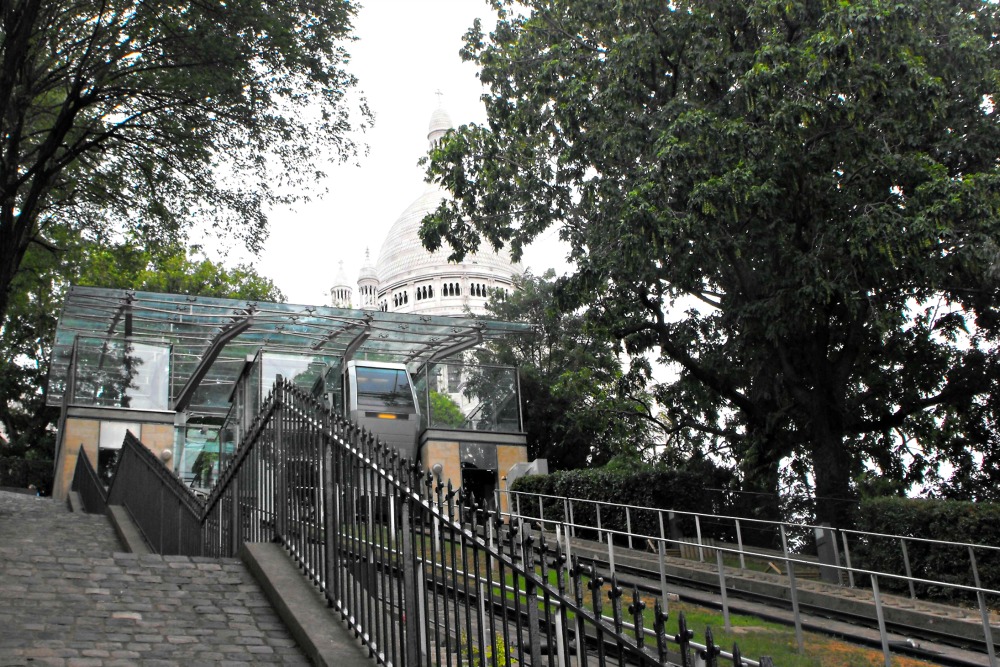
After visiting Sacré-Coeur stay a little while on the steps to watch the sunset, and then wander back down the hill where you’ll stumble upon unspoiled lanes, quiet squares, and ivy-clad shuttered homes and gardens. Find the restaurant that looks just right for you and then stop for a leisurely dinner to cap off an evening in Paris.
TIP: Although pickpockets can be found in many parts of Paris, be extra vigilant in this area as there are many people around which make it easier for pickpockets to grab your stuff before you even realise it. There are also many scams to be aware of such as the ones mentioned here. You don’t need to be afraid, just careful. And don’t feel the need to speak to anyone who approaches you.
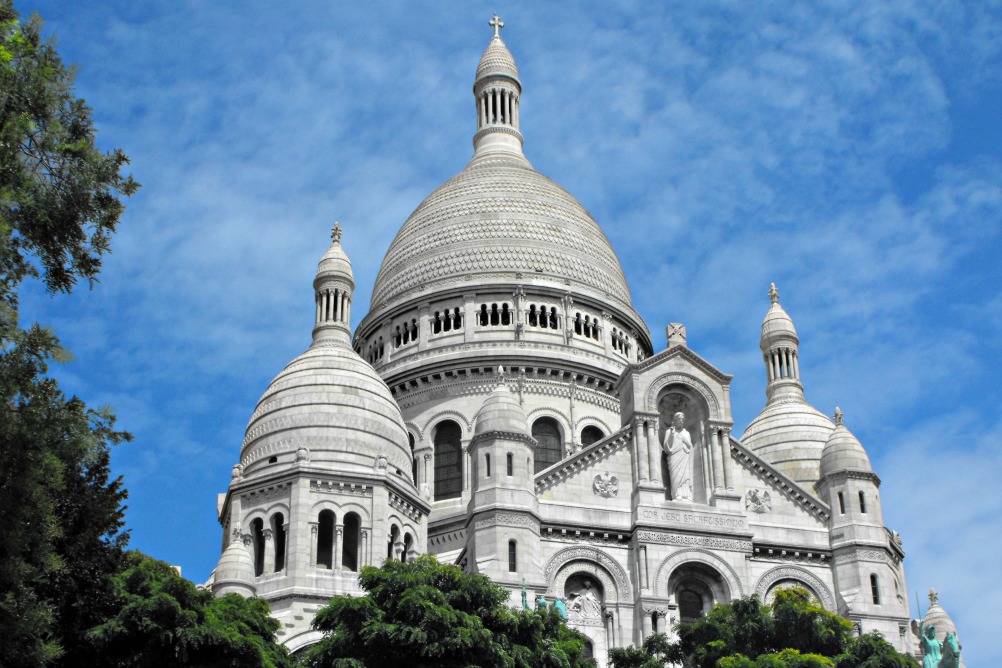
SACRÉ- COEUR
Sitting atop Paris’ tallest hill, the terraces in front of Sacré-Coeur offer one of the city’s most spectacular views by day, night, and especially at sunset. You can climb to the top of the steep corkscrew staircase of the dome for an even higher vantage point, but our recommendation is to save your energy for climbing the towers of Notre-Dame instead.
Construction on the basilica started in 1875 and it took 39 years to complete it to the top of its 83 m high dome. It was built as a symbol of national reconciliation and hope after France’s defeat in the 1871 Franco-Prussian War. The location at the top of the hill was chosen because, according to legend, the city’s patron saint – St. Denis – was martyred here.
Built with travertine, which bleaches with age, Sacré-Coeur seems to float as if on a cloud above the city and remains white no matter the weather.
WEBSITE: Basilique du Sacré-Coeur | ADDRESS: 35, Rue du Chevalier de la Barre 75018
NEAREST MÉTRO STOPS: Anvers (M°2) or Abbesses (M°12) and then take the funicular or steps to the top of the hill.
HOURS OF OPERATION: 0600 – 2230 daily (Click for Mass Times)
COST: Free to visit the church (climbing the dome is an additional charge)
HELPFUL LINK:
- To get more out of your visit you can download the official Sacré-Coeur audioguide.
SATURDAY MORNING
In the morning you’ll want to be up early to be out the door by about 9:00 am to allow enough time for the several planned stops and also to allow some time to just be in Paris, relax over lunch and maybe at a café for a little afternoon treat.
Start at Notre-Dame Cathedral on the island in the Seine River, the physical and historic centre of Paris. The closest Métro stops are Cité, Hôtel de Ville, and St. Michel, each a short walk away (click for Métro map).
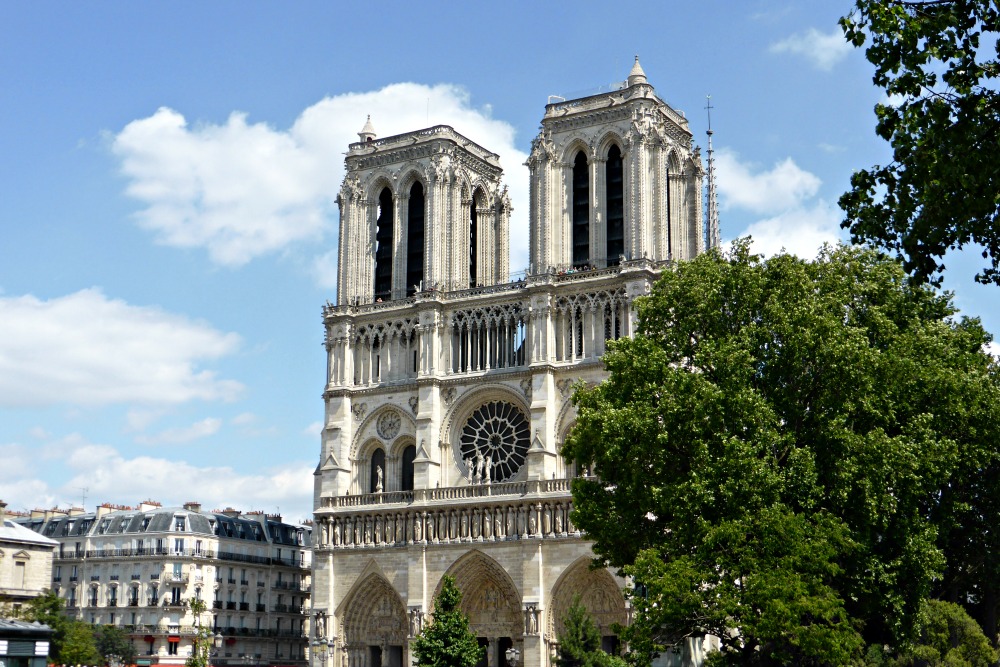
NOTRE-DAME CATHEDRAL
Both a religious mecca and a cultural icon, this Gothic cathedral towers above the Ile de la Cité and the Seine River which is why we’re recommending you take the time to make the climb up the towers.
The first stone was laid in 1163 and then it took another 180 years to build Europe’s first Gothic cathedral. It was built with soaring pillars, massive stained-glass windows, and intricate stone carvings both to inspire and to instil the fear of God. It is still as imposing today as it was all those hundreds of years ago.
After climbing the 422 steps, you’ll be rewarded with up-close views of the gargoyles, as well as views of the cathedral’s flying buttresses and then out over the historic streets and buildings that surround it. If you have time, come back at night to view it from the grounds when it is lit up with floodlights that showcase its spires, arches, statues, and gargoyles with a sense of drama and darkness. You can get a really good view from the Pont de la Tournelle.
WEBSITE: Cathédrale Notre-Dame de Paris | ADDRESS: 6 Parvis Notre-Dame, Place Jean-Paul II, 75004
NEAREST MÉTRO STOPS: Cité or Saint Michel (M°4) or Saint Michel – Notre Dame (RER B)
HOURS OF OPERATION: Monday – Friday 0800-1845 and Saturday/Sunday 0800-1915
COST: Free to visit the church but there is an additional charge to climb the towers (10€) or visit the crypts (8 €). Both entrance fees are included on the Paris Museum Pass but the “skip-the-line” perk is only available for the crypts.
From the front doors of Notre-Dame walk towards the river and then walk along beside the cathedral towards the park behind it. From this park you can actually get some really great photos of Notre-Dame from views you aren’t used to seeing.
Continue through the park towards the Square de l’Ile de France that is just past the Quai de l’Archevêché and you’ll find the Mémorial des Martyrs de la Déportation. It is only a few minutes walk from the cathedral, but could take longer if you linger in the park.
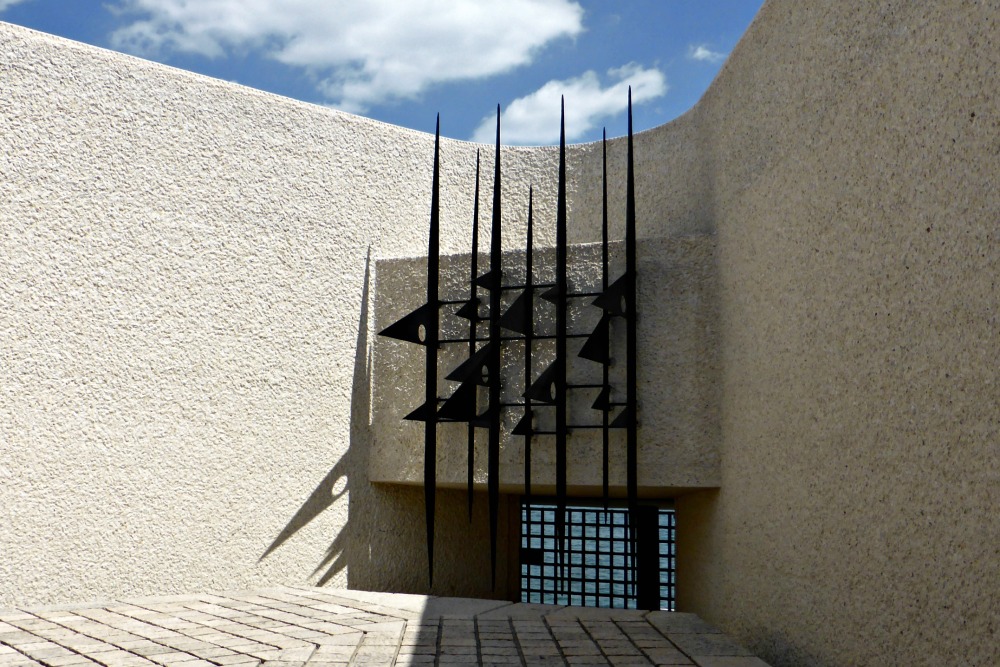
MÉMORIAL DES MARTYRS DE LA DÉPORTATION
Opened in 1962, this striking memorial was designed to evoke feelings of doom and claustrophobia, as so many would have felt during their time in the concentration camps. As you descend the steps, the city around you disappears, making you feel like a prisoner.
Once below street level, you enter a one-way hallway with 200,000 tiny lights that commemorate those that died and leads to an eternal flame. The memorial is also the resting place of an unknown deportee above whose tomb is an inscription that reads “Dedicated to the living memory of the 200,000 French deportees shrouded by the night and the fog, exterminated in the Nazi concentration camps”.
Along the hallway are little side rooms filled with triangles as reminders of the identification patches inmates were forced to wear with each one bearing the name of a concentration camp. And, as you exit, you will see a message above you that translates to “Forgive, but never forget“; familiar words if you have visited other Holocaust memorials.
Although not a popular destination for visitors to France, we feel this moving memorial is worth a quiet and reflective visit.
ADDRESS: Square de l’Ile-de-France, 7 Quai de l’Archevêché, 75004
NEAREST MÉTRO STOPS: Cité (M°4) and St-Michel Notre-Dame (RER B)
HOURS OF OPERATION: Open year-round Tuesday through Sunday (closed on Monday). Hours are usually 1000-1900 April to September and 1000-1700 October to March.
COST: Free
After visiting the memorial, walk back in the direction of Notre-Dame along the river on the Quai de Marché Neuf. Continue along that street next to the river until you reach the Pont Saint-Michel and then turn right. Walk a few more minutes and Sainte-Chapelle will be on your left.
It is 750 m between these sites and will take about 10 minutes to walk.
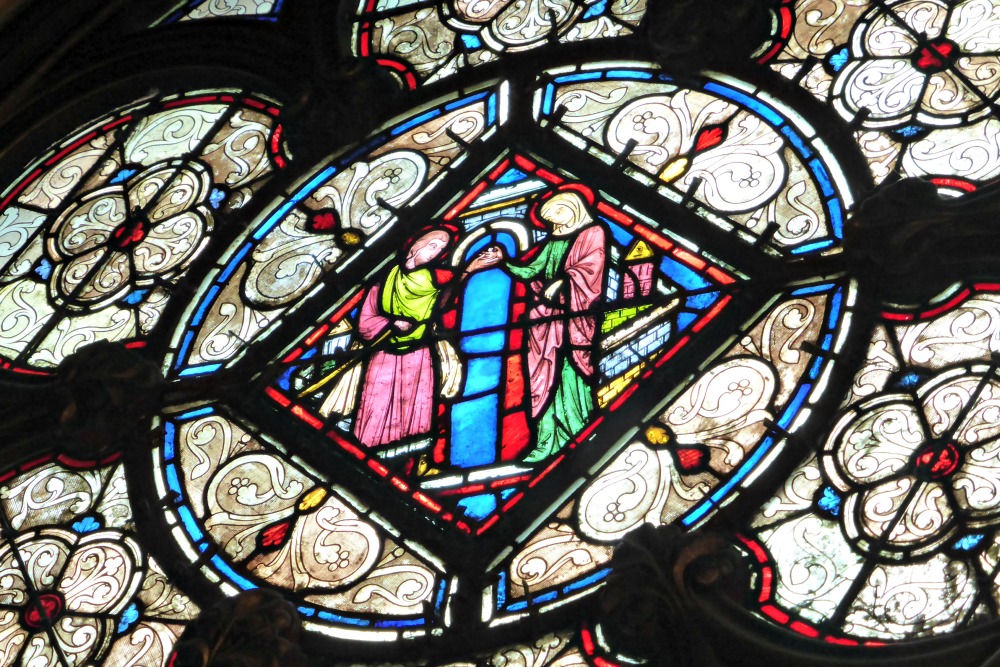
SAINTE-CHAPELLE
Built between 1242 and 1248 for King Louis IX, this church is somewhat unique in that it was built under the design of only one architect so it has a very cohesive design. The church was built to hold Christian relics brought back from the Middle East during the 13th-century crusades, especially Jesus’ Crown of Thorns (which is now kept at Notre-Dame).
The exterior is functional with great buttresses to hold up the stone roof, but the real stars are the walls that are almost entirely made out of stained glass so when the weather is right the interior is bathed in colourful light. There are more than 1,100 Bible scenes from the Creation to Judgement Day illustrated by the light and glass.
We’ve purposely not included a photo of the interior and we recommend not looking it up before you go; just visit and be amazed like we were.
WEBSITE: Sainte-Chapelle | ADDRESS: 8, Boulevard du Palais, 75001
NEAREST MÉTRO STOPS: Cité (M°4)
HOURS OF OPERATION: Oct 1 – March 31 open daily 0900 – 1700 / April 1 – Sept 30 open daily 0900 – 1900 / Closed January 1, May 1, and December 25
COST: 10€ or 8€ if qualify for discounts. Entrance fee is included on the Paris Museum Pass but it doesn’t allow you to skip the line for security to enter the church. You can also buy a ticket as a combo with the Conciergerie which is next door if you have time to visit there too.
HELPFUL LINKS:
- To get more out of your visit you can download the free Rick Steves’ Historic Paris Walk audio guide which includes a tour of the interior of Sainte-Chapelle or it is available in his Paris guidebook.
- The entrance fee is included on the Paris Museum Pass but it doesn’t allow you to skip the line for security to enter the church. You can also buy a ticket as a combo with the Conciergerie which is next door if you have time to visit there too.
After your visit to Sainte-Chapelle you may be ready for some lunch. Just across the street called Boulevard du Palais you’ll find a nice place called the ‘Brasserie Les Deux Palais‘ where you can find a delicious and affordable lunch. If it is a nice day, choose one of the tables outside and you can watch the hustle and bustle of the city as you dine.
SATURDAY AFTERNOON
After lunch, it’ll be time to head to the Louvre and these directions pick back up outside the entrance of Sainte-Chapelle.
From the entrance to Sainte-Chapelle turn left on to the Boulevard due Palais and cross the Pont du Change. Once over the bridge turn left on to the Quai de la Mégisserie and walk along the river.
You’ll go past the Pont Neuf and then the street changes names to the Quai du Louvre (it’ll still be running parallel with the river though) and continue until you reach the Rue de l’Admiral de Coligny and turn right. After about 100 more meters turn left into the courtyard that is at the back of the Louvre. There will be signs to point you in the right direction.
It is about 1 km between these sites and will take about 15 minutes to walk. You could take the métro to save about half the distance walking, but it really doesn’t save any time.
Alternatively, you could take the bus which stops about 75 m from the entrance to Sainte-Chapelle (turn left from the entrance). The stop is called Cité-Palais de Justice. It is the green line #21 and will take about 6 minutes (4 stops) to the stop called Palais Royal-Musée du Louvre. From there it will be about a 60 m walk to the entrance at the front of the Louvre where you will see the pyramid.
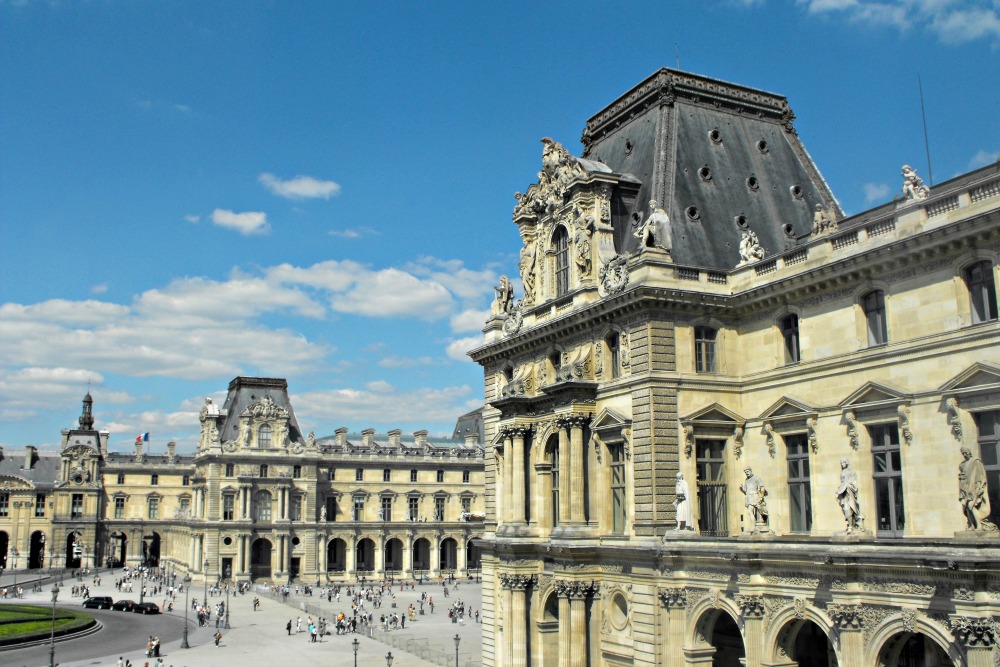
MUSÉE DU LOUVRE
The Musée du Louvre is one of the world’s largest museums and historical monuments and with 9.7 million visitors per year (15,000 per day!) it is the world’s most visited museum. It is located on the Right Bank of the Seine in the 1st arrondissement and is a central landmark of Paris.
The museum is housed in the Louvre Palace (Palais du Louvre} which was originally built in the late 12th century by Philip II as a fortress. It was then used as a palace until 1692 when Louis XIV decided to choose the Palace of Versailles for his residence instead. During the French Revolution, it was decreed that the museum be used to display France’s masterpieces and it officially opened on August 10, 1793, with an exhibition of 537 paintings and 184 art objects. Today the museum is home to over 380,000 objects from prehistory to the 21st century, with some 35,000 of those on display.
By 1874, the Louvre Palace had achieved its present form with the Sully, Richelieu, and Denon Wings but in 1983 French President François Mitterand proposed the Grand Louvre plan to renovate the building. The architect I.M.Pei was given the project and proposed a glass pyramid to stand over the new entrance to the main court, the Cour Napoléon. The pyramid was completed in 1989 and the Inverted Pyramid (La Pyramide Inversée)was then completed in 1993. Whether you love it or hate it I think all can agree it is a pretty impressive addition to an already stunning building.
TIP: You could spend days (weeks?) in the Louvre so our advice is to do a little advance planning to find your must-see pieces and then do them first. If you have time (and energy) for more then do a little exploring. Then leave the rest for your next visit to Paris.
WEBSITE: The Louvre | ADDRESS: 99, Rue de Rivoli 75001 1st Arrondissement
NEAREST MÉTRO STOPS: Palais-Royal Musée du Louvre (M°1 and M°7) and Pyramides (M°14)
HOURS OF OPERATION: Generally hours are as follows – Mon, Thurs, Sat, and Sunday: 0900 -1800 / Wed and Fri: 0900 – 2145 / Tues: Closed / Closed Jan 1, May 1, May, and Dec 25. For additional special hours please click here.
COST: Purchase online: €17 (for quicker entry to museum) / Purchase at the museum: €15 / Admission is free for all visitors on the first Sunday of the month from October to March and on July 14 but be prepared for crowds / All visitors under the age of 18 and 18-25-year-old residents of the EU, Norway, Iceland, and Liechtenstein are free all year round.
HELPFUL LINKS:
- To get more out of your visit you can download the free Rick Steves’ Louvre Museum Audio Tour or it is available in his books Mona Winks: Self-Guided Tours of Europe’s Top Museums and his Paris guidebook.
SATURDAY EVENING
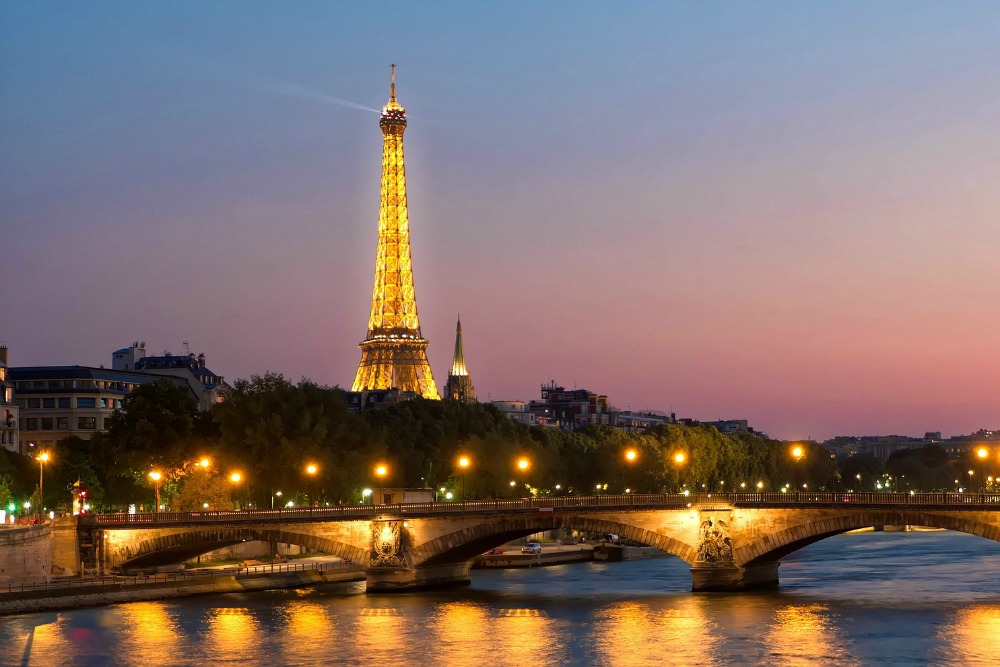
RIVER CRUISE ON THE SEINE
For a romantic way to see Paris, a river cruise in the evening can be a wonderful option. There are cruise only options, or treat yourself to one of the dinner cruises and see the dramatically lit monuments over dinner.
Typically you’ll be offered a multi-course meal in a dining room aboard a boat that has a glass top for a great view. If available, it may be worth it to pay the extra to also reserve a seat by the window as they are a little more private and have better views.
PLEASE NOTE: Many dinner cruises do have a dress code so it is worth checking that quickly before heading out.
The two most popular companies offering these cruises are Bateaux-Mouches and Bateaux Parisiens, but other options are available as well.
SUNDAY MORNING
There are a few métro stops close to the Eiffel Tower but we recommend going to the Trocadéro stop to start your day as it offers fantastic views of the Eiffel Tower and then you can walk the rest of the way to the tower.
Before ascending to the iron giant’s second floor (or summit) for spectacular views across the entire city, take some time to view the tower from Place du Trocadéro and then you can stroll through the gardens past the fountains.
If you arrive early enough you’ll beat the street vendors and many of the other visitors and you’ll be able to get fantastic shots of the Eiffel Tower.
After wandering through the gardens head towards the river and cross on the Pont d’Iéna and head straight towards the Eiffel Tower.
It is a little less than 1 km between these sites and will take about 12-15 minutes to walk.
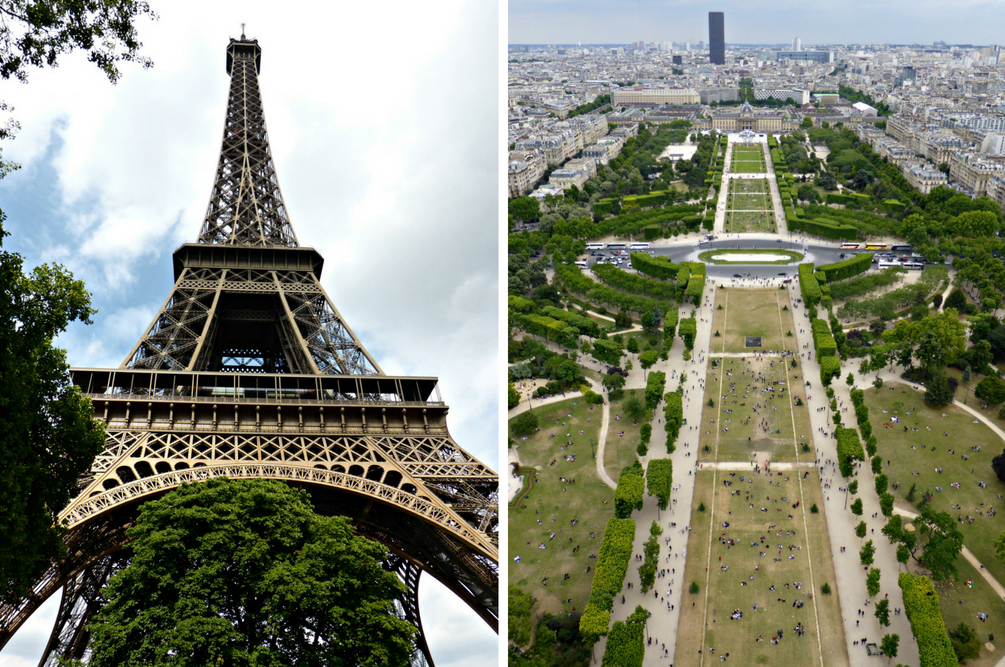
EIFFEL TOWER
Constructed in 1889 on the centenary of the French Revolution by engineer Gustave Eiffel, the tower that bears his name is still a symbol of France and one of the world’s most recognized structures. It is made from 18,000 pieces of iron held together with 2.5 million rivets to reach its height of 324 m.
It was originally meant to be temporary and be taken down after 20 years, but the advent of radio transmission saved it in the early 20th century as it was an ideal location for a radio antenna.
There are three viewing platforms – you can reach the first two by stairways, although there are 300 steps to each level, or you can take an elevator. The 2nd level has restaurants, souvenir shops, and the best views of the city from the tower because at the top level you are so high up everything looks like a little speck. The top-level can be reached by elevator only and on a clear day, you can see for about 64 km (40 miles). If you are pressed for time, we recommend going to the 2nd level only; you’ll avoid some of the lines and you will still get amazing views.
While in the city you should also make a little time to see the tower at night. Since 2000 the tower has incorporated two illumination systems – the static lighting and then the sparkling lighting that runs for five minutes on every hour beginning at 8 pm. While you can see the tower from many places around the city, the Champ de Mars provides an excellent viewing location and place to sit and just enjoy the feeling of being in Paris.
TIP: If you visit during busy times be prepared to queue for quite a while. You’ll need to queue both on the ground to get to the first elevator and then another line to get on the elevator to the top. There may also be a line to get on the elevator at the top to come back down. You can then take the stairs the rest of the way down to the ground to save some time (there are about 600 steps from the 2nd floor to the ground) if there are more lines at the elevator to come the rest of the way down.
WEBSITE: Eiffel Tower | ADDRESS: Champ de Mars, 5 Avenue Anatole 75007
NEAREST MÉTRO STOPS: Trocadéro (M°9), Bir-Hakeim (M°6), or École Militaire (M°8)
HOURS OF OPERATION: Open July 7 – Aug 26 from 0900 to 0:45 / Open rest of year from 0930 to 2345 / Closed July 14.
COST: Rates vary based on the level you wish to visit, whether you want to take the stairs to the 2nd level or not, and age. Click for complete price guide or to buy tickets. Please note if you purchase a ticket to the 2nd level you won’t be able to change that to go to the top once you are on the 2nd level so need to decide before purchasing how high you’d like to go.
Standing beside the Eiffel Tower if you are facing the river you will turn left and walk about 800 m (10 minutes) to the Bir-Hakeim métro station. This is on the green line (M°6). Take this train to the Charles de Gaulle Étoile stop which is about a 7-minute ride (5 stops). This will bring you right to the Arc de Triomphe at the end of the Champs–Élysées.
SUNDAY AFTERNOON
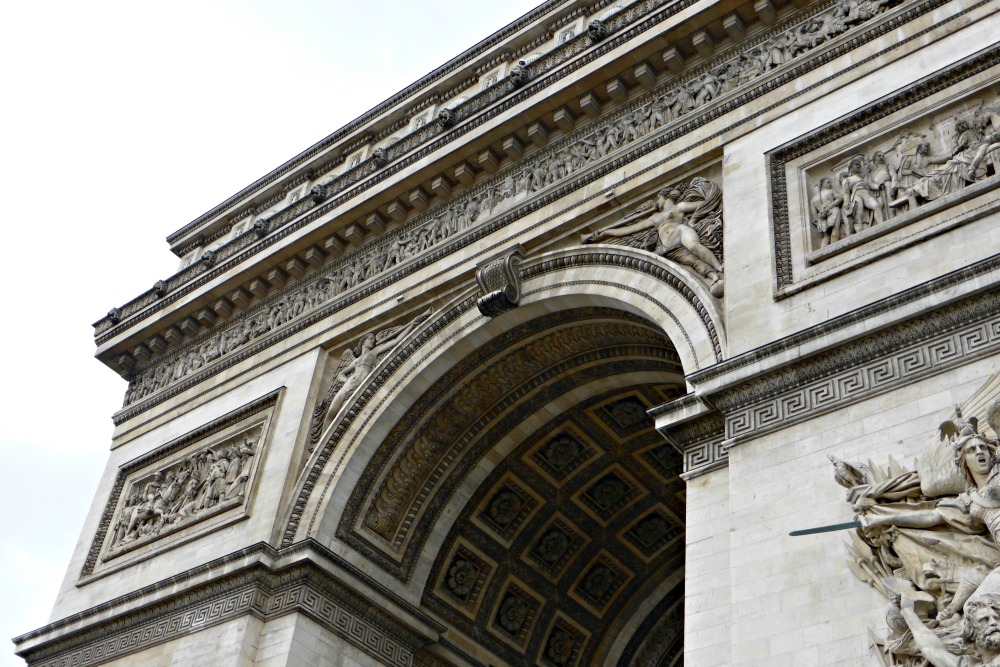
ARC DE TRIOMPHE
Situated at the meeting of 12 (yes twelve!) roads, the Arc de Triomphe is surrounded by the city’s busiest traffic circle.
Plans for the arch began in 1806 following Napoleon I’s victory over the Russo-Austrian army. It then took two years just to lay the foundation and it wasn’t completed until 1836. It was built to honour those who fought for France in the Revolutionary and Napoleonic Wars, and today the eternal flame burns in memory of the dead from both World Wars who were never identified.
Standing under the arch take in the sculptures, the six reliefs on the upper facades that represent significant moments of the Revolutionary and Napoleonic Wars, and the arcades decorated with allegorical figures from Roman, mythology. Finally, take a moment to pause at the ‘Tomb of the Unknown Soldier’ who is an unidentified French soldier from WWI that was laid to rest under the arch in 1921.
TIP: Do NOT try to cross the road to go under the Arc de Triomphe. There are underground pedestrian walkways that should be used for safety.
WEBSITE: Arc de Triomphe | ADDRESS: Place Charles-de-Gaulle, 75008
NEAREST MÉTRO STOPS: Charles-de-Gaulle-Etoile (M°1, M°2, and M°6)
HOURS OF OPERATION: Open daily Oct 1 – March 31 from 1000-2230 / Apr 1 – Sept 30 from 1000 – 2300 / Closed Jan 1, May 8 (morning), July 14, Nov 11 (morning), and Dec 25
COST: 12€ for adults and reduced price of 9€ for 18-25-year-olds from non-EU countries.
HELPFUL LINK:
- To get more out of your visit further information about the Arc de Triomphe is included on Rick Steves’ “Champs-Elysées Walk” in his Paris guidebook.
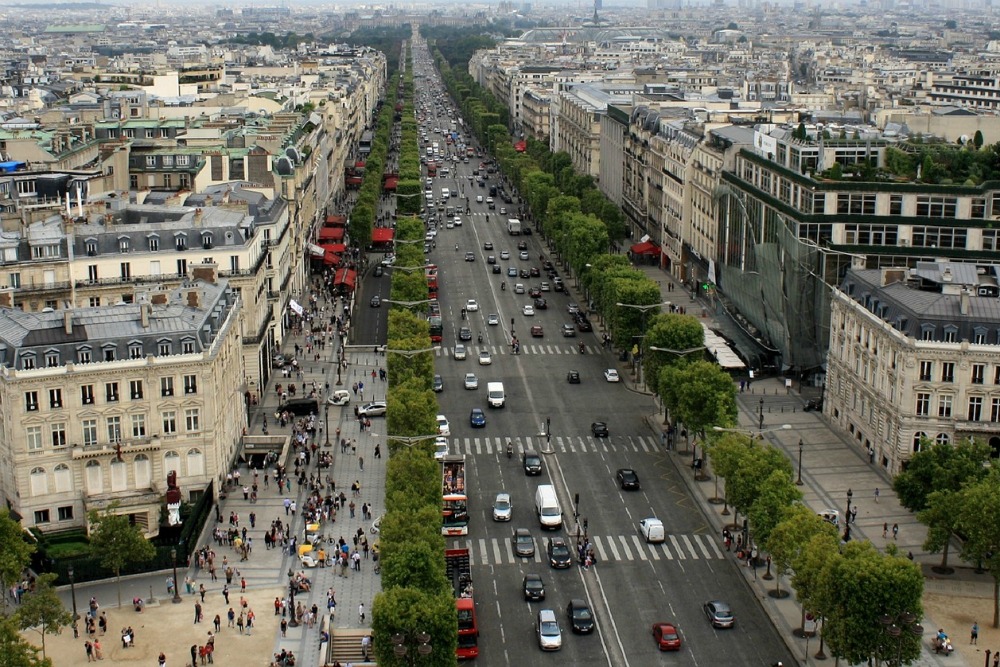
CHAMPS-ELYSÉES
End your weekend in Paris by strolling down the famous Paris boulevard – the Champs-Elysées. It opened in 1667 by Louise XIV and soon became the place to cruise in your carriage. Today is no different for people who want to see and be seen.
With its monumental sidewalks, stylish shops, elegant cafés, and glimmering showrooms you will have no end of things to see. If time allows also take little detours down little side streets which become quiet quite quickly. Here you will find little restaurants and cafés that you can pop into for lunch or an afternoon coffee before wrapping up your weekend in Paris.
Want to save this for later? Click the Pinterest button on the left for a pinnable image!
RESOURCES | PLAN YOUR WEEKEND IN PARIS
To book flights, rental cars, accommodations, and activities for your trip, please check out our recommended travel providers, favourite apps and websites.
Some of the links in the post above are affiliate links. This means if you click on the link and purchase the item, we will receive an affiliate commission but this does not affect the price to you. Please read our full disclosure policy here.
